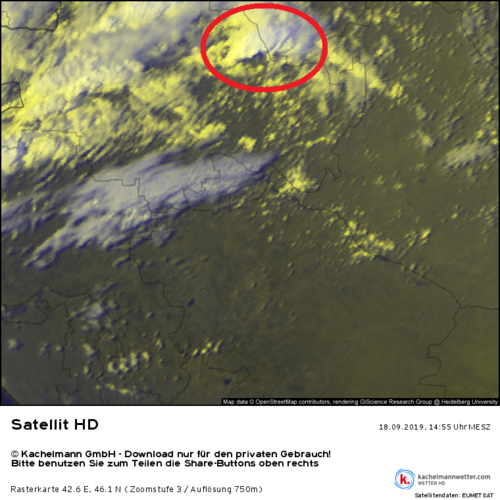Alex Dashevsky
Enthusiast
Hello everyone,
This is my first post here. I hope I've chosen the right forum.
In the afternoon of September 18, 2019, a rather powerful hailstorm hit the town of Volgodonsk, Rostov oblast, Russia. Spiky hailstones measuring up to 3-4 cm in diameter were reported.
I'd like to know if the storm was supercellular or not. Unfortunately, no radar data or photos are available. The only source of data is satellite imagery. It shows a long-lived convective process deviating slightly to the right of the mean flow. The development of new cells on the storm's trailing side is more discrete rather than continuous, suggesting a multicell structure.
This is the satellite imagery of the storm at the time it hit Volgodonsk: Satellit HD-Bild vom 18.09.2019, 14:45 Uhr - Rostow am Don. "Animation" in 5-min increments can be done manually by clicking at "back" and "forward" time navigation buttons.
Local self-taught weather experts insist that it was a "pulsing" LP supercell. I've never encountered "pulsing LP supercells" in the literature, and I'm perfectly aware that it's often hard to identify a supercell only by looking at satellite and photos of hailstones. However, what are the chances that it really was a supercell? Thanks in advance for your answers.
I'm sorry for my bad English.
P. S. Here's a link with GFS model data for Europe: Estofex Meteorological Data.
This is my first post here. I hope I've chosen the right forum.
In the afternoon of September 18, 2019, a rather powerful hailstorm hit the town of Volgodonsk, Rostov oblast, Russia. Spiky hailstones measuring up to 3-4 cm in diameter were reported.
I'd like to know if the storm was supercellular or not. Unfortunately, no radar data or photos are available. The only source of data is satellite imagery. It shows a long-lived convective process deviating slightly to the right of the mean flow. The development of new cells on the storm's trailing side is more discrete rather than continuous, suggesting a multicell structure.
This is the satellite imagery of the storm at the time it hit Volgodonsk: Satellit HD-Bild vom 18.09.2019, 14:45 Uhr - Rostow am Don. "Animation" in 5-min increments can be done manually by clicking at "back" and "forward" time navigation buttons.
Local self-taught weather experts insist that it was a "pulsing" LP supercell. I've never encountered "pulsing LP supercells" in the literature, and I'm perfectly aware that it's often hard to identify a supercell only by looking at satellite and photos of hailstones. However, what are the chances that it really was a supercell? Thanks in advance for your answers.
I'm sorry for my bad English.
P. S. Here's a link with GFS model data for Europe: Estofex Meteorological Data.





